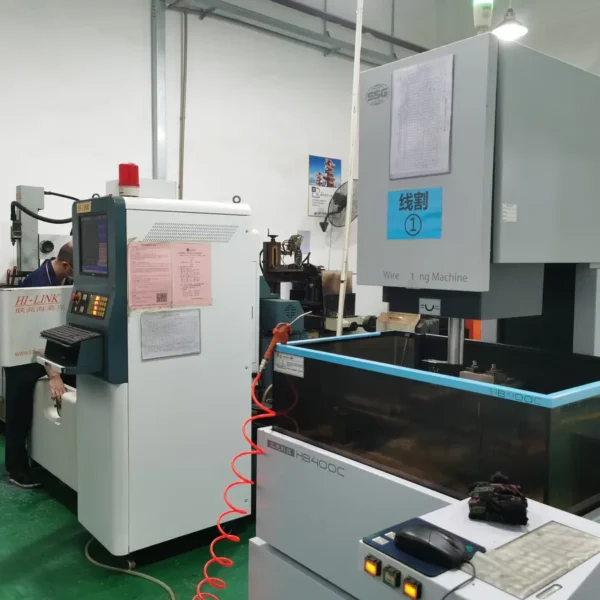
EDM (Wire Electrical Discharge Machining)
Wire Electrical Discharge Machining (EDM) employs pulsed discharges to erode metal, enabling non-contact precision machining of wire-cut/complex geometries. Based on electrode wire speed and process characteristics, this technology is categorized into three main types: High-Speed Wire (WEDM-HS), Medium-Speed Wire (WEDM-CS), and Low-Speed Wire (WEDM-LS).
Each exhibits distinct differences in machining efficiency, precision, cost, and application domains, collectively forming a complete technological chain spanning from rough machining to ultra-precision component manufacturing.
I. Technical Principles and Core Parameter Comparison
1. High-Speed Wire (WEDM-HS): “Efficiency-Priority” Mode for Rapid Removal
Wire Feed Speed: 8-10 m/s (repetitive motion of molybdenum wire). High-frequency repetitive cycles of the electrode wire reduce consumable costs.
Processing Accuracy: ±0.01-0.03 mm. Surface roughness Ra 2.5-3.5 μm due to vibration from high-speed movement, requiring subsequent polishing.
Typical Parameters: Pulse width 100-200μs, peak current 100-150A, cutting speed 50-400 mm/min.
Technical Limitations: Single-pass cutting process leaves distinct striations on machined surfaces, making it unsuitable for high-finish requirements.
2. Medium Wire-Cut EDM (WEDM-CS): The “Balancing Approach” of Composite Wire-Cut
Wire feed speed: 1-10 m/s (variable speed adjustment). High speed (8-10 m/s) is used during roughing for efficiency, switching to low speed (1-3 m/s) during finishing for precision.
Machining Accuracy: ±0.005–0.01 mm. Achieves surface roughness Ra 0.65–1.5 μm through three or more cutting stages (rough cut → fine trim → polishing).
Typical Parameters: Roughing stage peak current 80–120 A; finishing stage peak current 10–20 A; pulse width 1–10 μs.
Technical Breakthrough: Utilizes a closed-loop servo control system that adjusts electrode wire tension and position through real-time feedback, limiting material deformation to within 0.005 mm.
3. Slow Wire (WEDM-LS): The “Precision Revolution” of Low-Speed Unidirectional Movement
Wire Feed Speed: 0.001-0.2 m/s (unidirectional copper wire movement), employing single-use electrodes to eliminate wear-induced errors.
Processing Accuracy: ±0.001–0.005 mm, surface roughness Ra 0.1–0.8 μm, achieving mirror-like finishes.
Typical Parameters: Pulse width 1–10 μs, peak current 5–20 A, cutting speed 0.1–1 mm/min.
Technical Advantages: Utilizes non-electrolytic pulse power supply to control surface modification layer thickness below 2μm, delivering superior wear resistance on carbide punch edges compared to mechanical grinding.
II. Application Domains and Production Scenario Analysis
1. High-Speed Wire Cutting: Suitable for Mass Production
Typical Applications:
Rough machining of mechanical components: automotive stamping die blanks, preforming of shearing blades.
Low-precision structural components: Pliers parts, simple tooling fixtures.
Production Scenarios:
An appliance manufacturer reduced single-piece processing time for air conditioner compressor housings from 45 minutes (traditional milling) to 8 minutes, boosting equipment utilization by 60%.
A Zhejiang mold factory achieved daily output of 200 stamping dies via high-speed wire cutting—tripling efficiency over conventional methods.
2. Medium-Speed Wire-Cut EDM: Cost-Effective Precision Manufacturing
Typical Applications:
Mold Manufacturing: Precision finishing of plastic injection molds and die-casting molds.
Aerospace: Contour cutting of aircraft support structures and spacecraft connectors.
Medical Devices: Precision forming of surgical blades and orthopedic implants.
Production Scenarios:
An electronics factory employs medium-speed wire cutting to process metal phone frames. Through a three-step cutting process, surface roughness was reduced from Ra3.2μm to Ra0.8μm, boosting yield rates from 78% to 95%.
An aerospace component manufacturer utilizes medium-speed wire cutting for titanium alloy blades. Variable-speed wire control minimized the heat-affected zone, enhancing material fatigue strength by 15%.
3. Slow Wire-Cut EDM: High-End Manufacturing for Ultimate Precision
Typical Applications:
Semiconductor molds: Microstructure machining for lead frame molds and chip packaging molds.
Precision Transmission: High-precision gear and worm gear profile cutting.
Optical Components: Aspheric lens molds, laser focusing lens cavity machining.
Production Scenarios:
A semiconductor company employed slow-speed wire cutting for 12-inch wafer dicing molds. Using a 0.02mm electrode wire, they achieved slot width tolerances of ±0.002mm with tool life reaching 500,000 strokes.
A German precision machinery factory employed slow-speed wire cutting for watch gears. Dual-wire exchange technology reduced processing time from 8 hours to 3 hours while maintaining surface roughness at Ra 0.05μm.
High-speed, medium-speed, and slow-speed wire cutting technologies respectively represent the ultimate pursuit of efficiency, cost, and precision in EDM wire cutting. High-speed wire cutting fulfills basic manufacturing demands through low-cost mass production, while medium-speed wire cutting achieves a cost-performance balance via composite wire movement and multiple-pass cutting techniques.
Slow-speed wire cutting defines high-end manufacturing standards with nanometer-level precision. Through the integration of intelligent control, composite machining, and green manufacturing technologies, EDM wire cutting is evolving from a single processing method into intelligent manufacturing cells, providing critical technological support for strategic industries such as aerospace, semiconductors, and medical devices.
